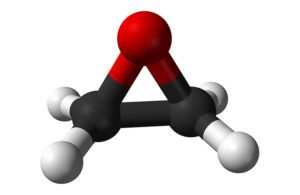
Model of an ethylene oxide molecule.
The types of regulatory hurdles that contributed to the permanent closure this week of the Sterigenics medtech sterilization plant in Willowbrook, Ill., have created a “rolling effect” on ethylene oxide (EO) plants around the country, according to an industry official.
The state of Illinois temporarily shut down the Willowbrook plant in February over emissions of EO, a colorless, odorless gas that the federal Environmental Protection Agency (EPA) considers a carcinogen. The plant’s sudden closure caused some device shortages and a push by the FDA to come up with ways to improve EO sterilization as well as alternative sterilization methods.
Illinois updated its law in June to further restrict EO emissions beyond federal government standards, but many EO plants have been operating under state emissions control permits issued before the EPA lowered its limits in 2016. The EPA is under a court order to issue a new rule governing EO emissions by March 2020. In the meantime, the nation’s medtech sterilizers — about a third of which are small businesses — will continue to be subject to a variety of state and local regulations.
Sterigenics and state officials reached a consent agreement in July and the company secured a state environmental permit last week that would have allowed the Willowbrook plant to reopen. Instead, Sterigenics pulled the plug on Monday, citing “inaccurate and unfounded claims regarding Sterigenics and the unpredictable legislative and regulatory landscape in Illinois.” The company also said it was unable to negotiate a new lease agreement for one of its two EO facilities in Willowbrook.
Sterigenics temporarily shut an EO plant in Atlanta on August 26 to voluntarily upgrade emissions controls. Last week, Cobb County, Ga. officials declared the Atlanta plant a “high-hazard” industrial facility that must meet stiffer fire safety regulations than it needed to under its previous designation as a storage facility. The county ordered Sterigenics to stop construction until it obtains a new certificate of occupancy.
“Sterigenics has always operated with a focus on safety and is committed to completing the voluntary enhancements at our Atlanta facility to further reduce ethylene oxide emissions below already safe levels,” the company said yesterday. “We continue to engage with officials regarding the process to resume operations. We have made significant progress in completing the necessary construction to implement the enhancements approved by the Georgia EPD (Environmental Protection Division). The sterilization of vital medical products and devices at our Atlanta facility is critical to keeping patients safe and extended delay in resuming those operations places patient safety at risk.”
There are about 100 medtech sterilization facilities located throughout the country, according to the EPA. Becton Dickinson (NYSE:BDX) operates two of them in Covington and Madison, Ga., southeast of Atlanta. BD said in August that it will spend $8 million to upgrade emissions controls at those plants, although they are in compliance with federal EO emissions controls requirements. BD also said that it is working with state officials on the permitting process.
The new federal rule can’t come too soon for the medtech industry, according to Greg Crist, head of government affairs for medtech trade group AdvaMed. “I’m talking about the sterilization ecosystem. Sterigenics is certainly a part of it,” Crist told Medical Design & Outsourcing in an interview. “They are a third of that industry. You have to be sensitive to that. We’re talking about the entire ecosystem and it is related to the federal rule. In the absence of that rule, you’re seeing state officials feeling compelled to act.”
Some states do not have the industrial or toxicological expertise needed to make these decisions, Crist added. He said AdvaMed has been pressuring the EPA to complete its work on the new rule.
Crist also called state officials’ actions in Illinois, Georgia and Michigan — where emissions problems contributed to a decision by Viant to close an EO plant in Grand Rapids this year — a “rolling effect” that could continue across the country.
Concerns about EO emissions have also riled people who live and work near the plants in Illinois and Georgia. Willowbrook-area residents have filed more than 40 lawsuits against Sterigenics, claiming that emissions from the Willowbrook plant have caused health problems. Naperville, Ill.-based attorney Shawn Collins represents some of those plaintiffs.
“The announcement today that Sterigenics has decided not to reopen its Willowbrook facility, while a victory for the people fighting Sterigenics’ unsafe ethylene oxide emissions, is also a sad reminder that it should never have been allowed to operate there in the first place,” Collins wrote in an email to Medical Design & Outsourcing on Monday. “For years, Sterigenics spewed its cancer-causing chemical into a neighborhood filled with schoolchildren, teachers, moms and dads who had no idea they were ever in danger. Dozens of lawsuits filed against the company claim that Sterigenics’ chemical emissions gave them cancer or, even worse, caused the death of a family member. I hope news of the company’s closing is of some solace to them, and that no community will ever again be treated as callously as they were.”


